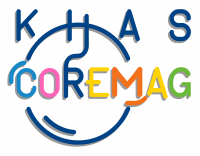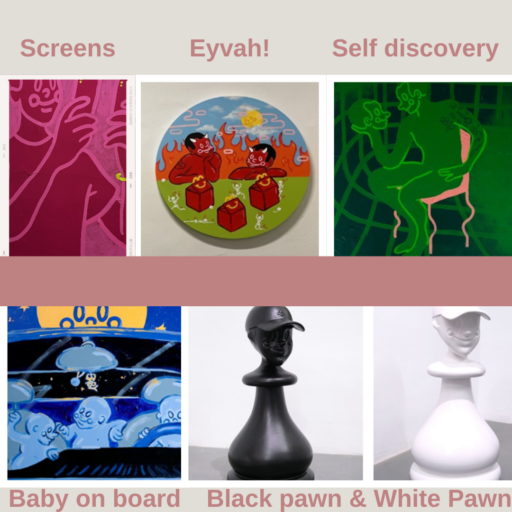Being One Of The Paintings
25 Mart 2024Sude Diken
We all consciously or unconsciously try to reflect our existential pains and the difficulties we experience in our personal journeys to those around us. Melih Çebi, in his exhibition “Baby on Board,” intentionally expressed his personal journey and observations with his own unique and dark humor. What caused me to attend the exhibition and what I loved most about it is the feeling of “Realness.” The exhibition is not based on fantasy, utopia, or non-existent things. It encompasses reflections of everything the 21st century possesses and individual issues. The reason it feels so genuine, in my opinion, is that the exhibition’s theme is approached in a general sense. When we look around us, we see the fast-paced metropolitan life we are in, the rapidly changing social media trends, existential pains, the search for identity, the consumer society we were born into, and the daily creation of trends and products designed to be consumed, and of course, the depression that comes with the convergence of these factors, namely capitalism, materialism, and consumer culture. All of these aspects have been intricately woven into Çebi’s art in the exhibition. And I must say that the theme has been so well executed that upon entering the exhibition, it served as a mirror to me.
“Self-Discovery” (2020). In Cebi’s work, we see Hamlet’s tirade of “to be or not to be” in which he oscillates between life and death. While Hamlet talks about topics such as human existence and death, suppressing the humorous content, Çebi, in parallel, says that the meaning of life starts with understanding oneself, and adds a humorous aspect to the event with his drawing technique.
In “Screens” (2020), we see a reference to the social media and digital world that we have become their almost slaves. The character holding two phones symbolizes that he is also an active part of consumer society, and the fact that the color of the bracelet on the character’s wrist matches that of the phone camera gives us the message of our addiction to seeing the world in digital ways.
“Since the end of World War II, the configuration of an empty self has emerged in the middle classes. It is empty in part because of the loss of family, community, and tradition (Levin, 1987a; Rieff, 1966; Zaretsky, 1976). It is a self that seeks the experience of being continually filled up by consuming goods, calories, ex-experiences, politicians, romantic partners, and empathic therapists in an attempt to combat the growing alienation and fragmentation of its era. (Cushman,1990,p.60)” These words by Philip Chusman about the empty self-theory in the 90s actually help us understand the character and works created by Çebi. Çebi reflects the process of the modern age where people are drawn into the cycle of consumption and are emotionally depleted as a result of the increasing speed of consumption. Additionally, the transformation of humans from emotional abstract beings into materialistic, concrete entities and the disappearance of individuality are depicted through the similarity and monotony of the characters created by Çebi.
We can see in Çebi’s work “Eyvah!” (2019) how we turn our backs on consumer society and the social disaster that is emerging without being aware of anything. The used fast-food boxes represent the consumer culture and the disaster that the society is being dragged into is depicted in the flames in the background. The “Bebek” figures, who still look happy in the foreground, symbolize how we remain oblivious to the situation.
The “Baby”, is the main star of Çebi’s work. As I mentioned before, I believe that the reason why all of the characters used in his works are the same or similar is to represent the fact that everyone is similar and in the new age resembles each other, and becomes ordinary. Regarding why the character is in the form of a baby, Çebi explained in an interview, “I think ‘Baby’ explains itself. I try to stay as someone who generally looks at things with fresh eyes.” (Civan, 2021). This can be interpreted as a reflection of Çebi’s innovative nature as an artist and his desire to look at life like newborn babies eyes Additionally, the “Baby” character is a playful reference to Çebi’s fear of growing up, which he has mentioned in interviews, and he even self-diagnosed himself as “Peter Pan” syndrome. The round shape of the baby’s head represents a camera, which is a reference to the fact that the exhibition is a reflection of society and that Çebi is observing society itself, including us.
The painting “Baby on Board” (2023), which the exhibition takes its name from, we see the reflection of Çebi’s struggles with the desire physically and mentally not to grow up. A moving car represents the passing of time, and the “Baby” figure inside it symbolizes the representative of this struggle of wanting to stay as a child. The steering wheel represents directing and keeping life on track, while the facial expressions of the other babies and the presence of a baby not an adult in the driver’s seat show us the feeling of inexperience and cluelessness.
In my visual analysis of the paintings, the use of imagery and the influence of the art movement cannot be overlooked. We can see that Çebi’s humorous and satirical style is predominantly aligned with the “Lowbrow” movement, also known as Pop Surrealism. The Lowbrow movement that appeared in the late 1970s is a combination of various art movements such as Dadaism, Pop Art, etc. It is a form of art that goes against elitist and high art and is often described as street art. Çebi attributes this irony to his lack of art education and his use of art as a self-expression method but not only as an aesthetic pleasure. Furthermore, considering that the subject matter of 21st-century Lowbrow art revolves around popular cultural elements that are humorously portrayed, it is appropriate to label Çebi as a lowbrow artist and acknowledge his success within this movement.
I would have loved to analyze every painting in the exhibition, but “Black Pawn & White Pawn” (2023) stood out a few steps ahead of the others for me. Pawns are the most abundant and ordinary pieces on the chessboard. The king, representing power and authority, the queen, with its versatility and strategic intelligence, the rook, representing solidity and durability, and the pawns, sacrificed to protect other pieces in the game and generally the last piece we would want to be in life. , The desire to be at the center of attention and the fear of being on the side can be explained by the pawns and basic chess. Pawns, which have been pushed to the bottom of the priority list in both the game and real life, gain a different meaning and value with Çebi’s touch. Çebi’s pawns have faces, which give them character and personality, taking them out of ordinariness. These pawns manage to break away from the crowd and become potential pawns to checkmate the opponent in the game. They no longer appear just as a society but as individuals on their own. You may feel like an ordinary pawn in your life right now but you never know when you’ll get the opportunity to checkmate to life.
Bibliography
Cushman P. Why the self is empty. Toward a historically situated psychology. Am Psychol. 1990 May;45(5):599-611. doi: 10.1037//0003-066x.45.5.599. PMID: 2190505.
Civan, Y. (2021, October 9). Melih Çebi ile: Sinsi ve Muzip Sanat Üretimleri Üzerine. theMagger. other. Retrieved May 5, 2023, from https://www.themagger.com/melih-cebi-kimdir-roportaj/.
UZUN E, ATILGAN P (2022). POP SÜRREALİZM’İN KULLANDIĞI POPÜLER KÜLTÜR ÖĞELERİ. İmgelem (Online), 6(11), 501 – 516. 10.53791/imgelem.1086433

